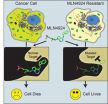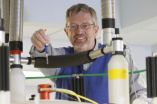(Press-News.org) A Harvard archaeologist has dramatically simplified the process of finding early human settlements by using computers to scour satellite images for the tell-tale clues of human habitation, and in the process uncovered thousands of new sites that might reveal clues to the earliest complex human societies.
As described in a paper published March 19 in the Proceedings of the National Academy of Sciences, Jason Ur, the John L. Loeb Associate Professor of the Social Sciences, worked with Bjoern Menze, a research affiliate in MIT's Computer Science and Artificial Intelligence Laboratory to develop a system that identified settlements based on a series of factors – including soil discolorations and the distinctive mounding that results from the collapse of mud-brick settlements.
Armed with that profile, Ur used a computer to examine satellite images of a 23,000 square-kilometer area of north-eastern Syria, and turned up approximately 9,000 possible settlements, an increase of "at least an order of magnitude" over what had previously been identified.
"I could do this on the ground," Ur said, of the results of the computer-aided survey. "But it would probably take me the rest of my life to survey an area this size. With these computer science techniques, however, we can immediately come up with an enormous map which is methodologically very interesting, but which also shows the staggering amount of human occupation over the last 7,000 or 8,000 years.
"What's more, anyone who comes back to this area for any future survey would already know where to go," he continued. "There's no need to do this sort of initial reconnaissance to find sites. This allows you to do targeted work, so it maximizes the time we have on the ground."
### END
Spotting ancient sites, from space
Harvard archaeologist uses computers and satellite images to search for early human settlements
2012-03-20
ELSE PRESS RELEASES FROM THIS DATE:
Sanford-Burnham scientists unravel cancer drug's secret to resistance
2012-03-20
LA JOLLA, Calif., March 19, 2012 – Drug resistance is a serious problem for cancer patients—over time, a therapy that was once providing some benefit simply stops working. Scientists at Sanford-Burnham Medical Research Institute (Sanford-Burnham) recently discovered how cancer cells develop resistance to a drug called MLN4924. This experimental therapy is currently being tested in a number of Phase I and Phase I/II clinical trials to determine its efficacy against several different types of cancer, including multiple myeloma, leukemia, and lymphoma.
Published online March ...
Solving the mystery of blood clotting
2012-03-20
How and when our blood clots is one of those incredibly complex and important processes in our body that we rarely think about. If your blood doesn't clot and you cut yourself, you could bleed to death, if your blood clots too much, you could be in line for a heart attack or stroke. Dr. Hans Vogel, a professor at the University of Calgary, has thought a lot about blot clotting and recently published research in the prestigious Journal of the American Chemical Society that helps to better understand the clotting process.
Vogel and his graduate student Hao Huang were able ...
Smell is a symphony
2012-03-20
Just like a road atlas faithfully maps real-word locations, our brain maps many aspects of our physical world: Sensory inputs from our fingers are mapped next to each other in the somatosensory cortex; the auditory system is organized by sound frequency; and the various tastes are signaled in different parts of the gustatory cortex.
The olfactory system was believed to map similarly, where groups of chemically related odorants - amines, ketones, or esters, for example - register with clusters of cells that are laid out next to each other.
When researchers at the Stowers ...
Scientists develop a software tool for estimating heart disease risk
2012-03-20
University of Granada researchers have developed a software tool that makes an accurate estimation of the risk that a person has to suffer a heart disease. In addition, this software tool allows the performance of massive risk estimations, i.e. it helps estimating the risk that a specific population group has of suffering a heart condition. The researchers employed a sample including 3 000 patients.
Heart conditions increasingly affect working age population, which can make individuals loss potential years of work and productivity.
Understanding the risk for ...
Empowered citizens or hopeful bystanders?
2012-03-20
The new political appetite for 'localism' in town planning has triggered anxiety within local communities and amongst those charged with making it work, according to new research funded by the Economic and Social Research Council (ESRC).
A study led by Professor Nick Gallent of the Bartlett School of Planning, University College London, looked at how communities in Kent have sought to influence the policies of local authorities and service providers and how, in the recent past, they have engaged with planning professionals around the production of 'parish plans'. The ...
First complete full genetic map of promising energy crop
2012-03-20
Researchers in Wales and the United States have collaborated to complete the first high-resolution, comprehensive genetic map of a promising energy crop called miscanthus. The results – published in the current edition of the peer-reviewed, online journal PLoS One – provide a significant breakthrough towards advancing the production of bioenergy.
The breakthrough results from the long-term collaboration between energy crop company Ceres, Inc., based in Thousand Oaks, California, USA, and the Institute of Biological, Environmental and Rural Sciences (IBERS) at Aberystwyth ...
Lifestyle study highlights key differences in relapsing and progressive onset MS
2012-03-20
Patients with relapsing onset Multiple Sclerosis (MS) who consumed alcohol, wine, coffee and fish on a regular basis took four to seven years longer to reach the point where they needed a walking aid than people who never consumed them. However the study, published in the April issue of the European Journal of Neurology, did not observe the same patterns in patients with progressive onset MS.
The authors say that the findings suggest that different mechanisms might be involved in how disability progresses in relapsing and progressive onset MS.
Researchers asked patients ...
Scientists develop tools to make more complex biological machines from yeast
2012-03-20
Scientists are one step closer to making more complex microscopic biological machines, following improvements in the way that they can "re-wire" DNA in yeast, according to research published today in the journal PLoS ONE.
The researchers, from Imperial College London, have demonstrated a way of creating a new type of biological "wire", using proteins that interact with DNA and behave like wires in electronic circuitry. The scientists say the advantage of their new biological wire is that it can be re-engineered over and over again to create potentially billions of connections ...
Researchers develop blueprint for nuclear clock accurate over billions of years
2012-03-20
A clock accurate to within a tenth of a second over 14 billion years – the age of the universe – is the goal of research being reported this week by scientists from three different institutions. To be published in the journal Physical Review Letters, the research provides the blueprint for a nuclear clock that would get its extreme accuracy from the nucleus of a single thorium ion.
Such a clock could be useful for certain forms of secure communication – and perhaps of greater interest – for studying the fundamental theories of physics. A nuclear clock could be as much ...
Soy-based S-equol supplement reduces metabolic syndrome risk factors
2012-03-20
Washington, DC. (March 19, 2012) – A 12-week treatment of the fermented soy germ-based nutritional supplement containing S-equol significantly lowered hemoglobin A1c (HbA1c), LDL cholesterol and improved vascular stiffness, all factors that occur as part of metabolic syndrome, according to a first-of-its-kind peer-reviewed study reported in a poster at the Women's Health 2012 annual meeting.
"This study is the first to provide evidence that a daily supplement of soy-based S-equol favorably change metabolic syndrome risk factors, particularly in women. Because not all ...
LAST 30 PRESS RELEASES:
Numbers in our sights affect how we perceive space
SIMJ announces global collaborative book project in commemoration of its 75th anniversary
Air pollution exposure and birth weight
Obstructive sleep apnea risk and mental health conditions among older adults
How talking slows eye movements behind the wheel
The Ceramic Society of Japan’s Oxoate Ceramics Research Association launches new international book project
Heart-brain connection: international study reveals the role of the vagus nerve in keeping the heart young
Researchers identify Rb1 as a predictive biomarker for a new therapeutic strategy in some breast cancers
Survey reveals ethical gaps slowing AI adoption in pediatric surgery
Stimulant ADHD medications work differently than thought
AI overestimates how smart people are, according to HSE economists
HSE researchers create genome-wide map of quadruplexes
Scientists boost cell "powerhouses" to burn more calories
Automatic label checking: The missing step in making reliable medical AI
Low daily alcohol intake linked to 50% heightened mouth cancer risk in India
American Meteorological Society announces Rick Spinrad as 2026 President-Elect
Biomass-based carbon capture spotlighted in newly released global climate webinar recording
Illuminating invisible nano pollutants: advanced bioimaging tracks the full journey of emerging nanoscale contaminants in living systems
How does age affect recovery from spinal cord injury?
Novel AI tool offers prognosis for patients with head and neck cancer
Fathers’ microplastic exposure tied to their children’s metabolic problems
Research validates laboratory model for studying high-grade serous ovarian cancer
SIR 2026 delivers transformative breakthroughs in minimally invasive medicine to improve patient care
Stem Cell Reports most downloaded papers of 2025 highlight the breadth and impact of stem cell research
Oxford-led study estimates NHS spends around 3% of its primary and secondary care budget on the health impacts of heat and cold in England
A researcher’s long quest leads to a smart composite breakthrough
Urban wild bees act as “microbial sensors” of city health.
New study finds where you live affects recovery after a hip fracture
Forecasting the impact of fully automated vehicle adoption on US road traffic injuries
Alcohol-related hospitalizations from 2016 to 2022
[Press-News.org] Spotting ancient sites, from spaceHarvard archaeologist uses computers and satellite images to search for early human settlements



